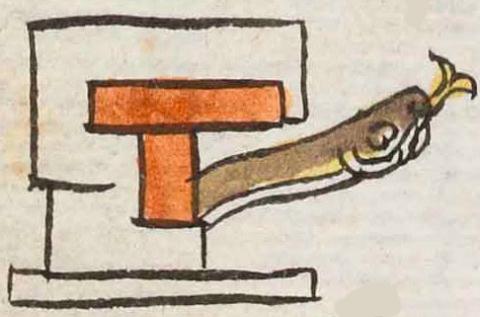Coacalco (Mdz24v)
This compound glyph for the place name Coacalco has two main elements, a brown and white snake/serpent (coatl), in profile, facing the viewer's right, and a white house/building (calli), also in profile, facing to the viewer's right. The snake's bifurcated tongue is protruding. The skin is smooth, and the belly is white. The house or building is rectangular, with a t-shaped entry way with wooden beams that are colored terracotta. The (-co) locative suffix is not shown visually, although it may be implied by the location of the building.
Stephanie Wood
Joaquín Galarza argued that this standard sign for calli was half of a building. But, if we flipped the building over and joined the two pieces together, the beam across the top would not be continuous because of the roof that hangs over the end of the beam.
Stephanie Wood
coacalco.puo
Coacalco, pueblo
Stephanie Wood
c. 1541, or by 1553 at the latest
Stephanie Wood
snakes, serpents, serpientes, casas, edificios, houses, buildings, architecture, casas, edificios, arquitectura, cohuatl, nombres de lugares

coa(tl), snake or serpent, https://nahuatl.wired-humanities.org/content/coatl
cal(li), house or building, https://nahuatl.wired-humanities.org/content/calli
-co (locative suffix), in or at, https://nahuatl.wired-humanities.org/content/co
"In the House of the Snake" (Karttunen apparently agrees with the interpretation by Berdan and Anawalt) [Frances Karttunen, unpublished manuscript, used here with her permission.]
"In the House of the Snake" (Berdan and Anawalt, 1992, vol. 1,
Codex Mendoza, folio 24 verso, https://digital.bodleian.ox.ac.uk/objects/2fea788e-2aa2-4f08-b6d9-648c00..., image 59 of 188.
The Bodleian Libraries, University of Oxford, hold the original manuscript, the MS. Arch. Selden. A. 1. This image is published here under the UK Creative Commons, “Attribution-NonCommercial-ShareAlike 3.0 License” (CC-BY-NC-SA 3.0).






